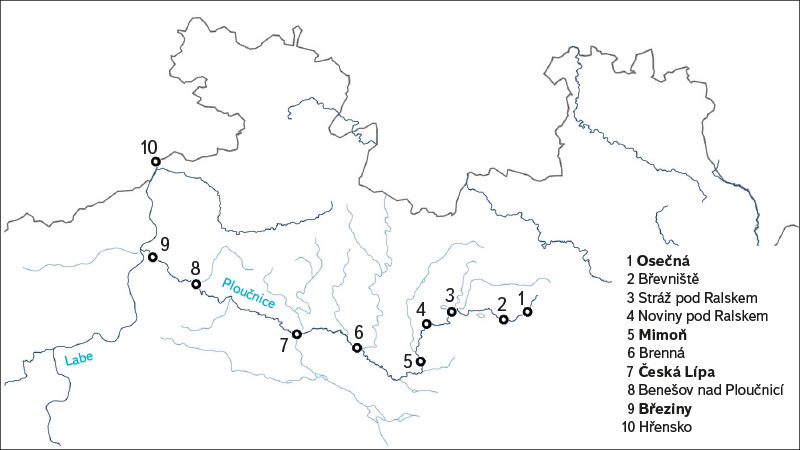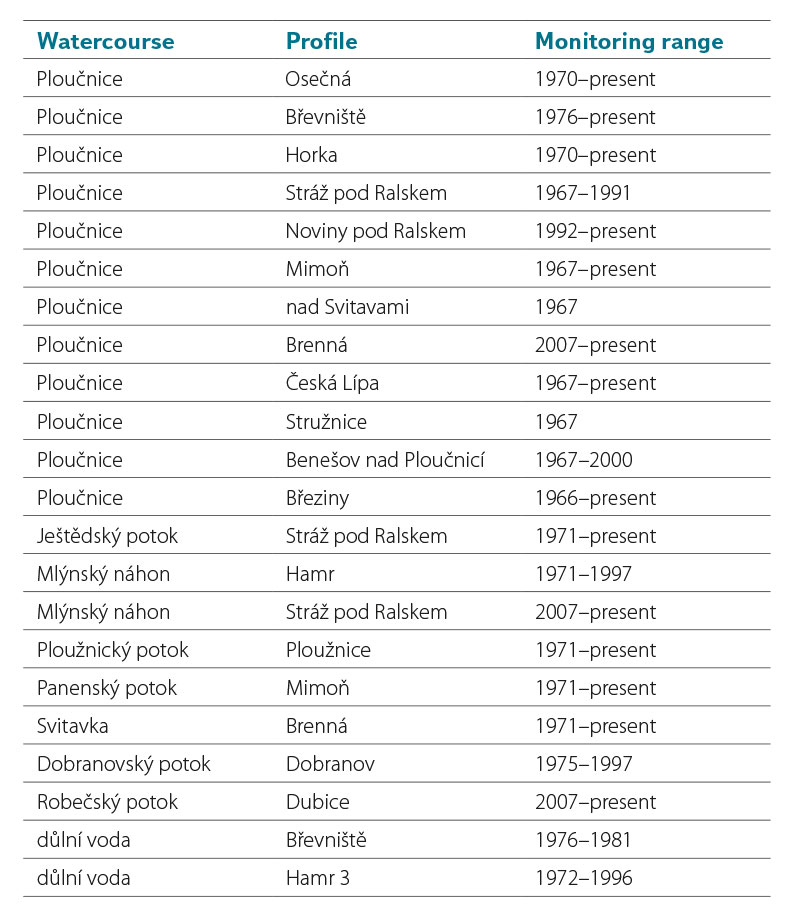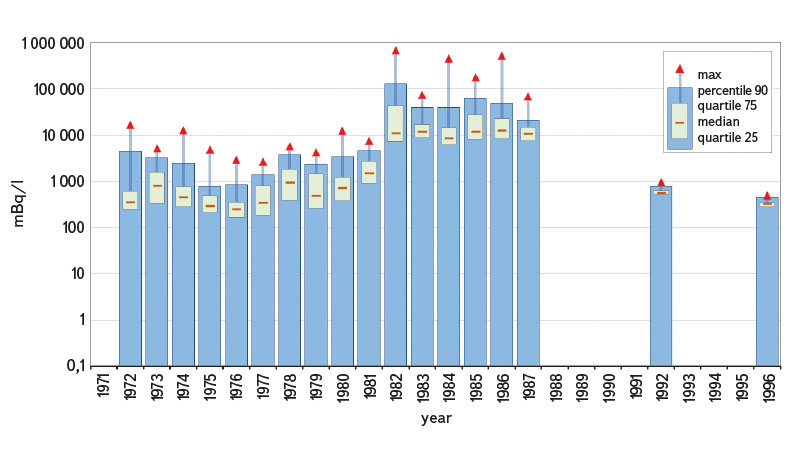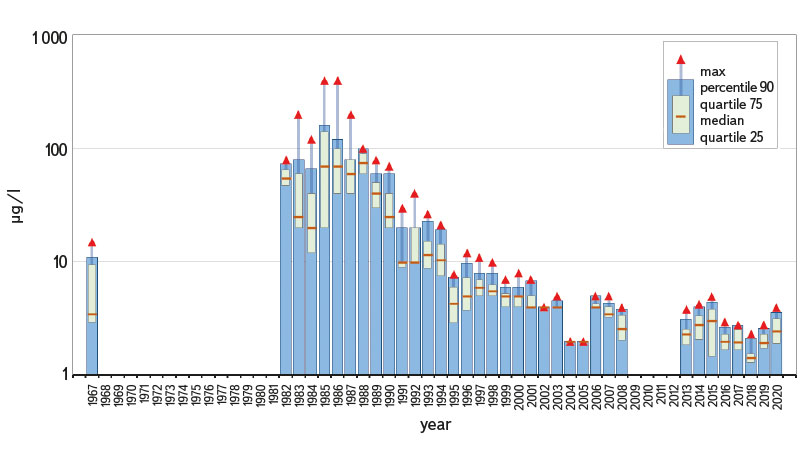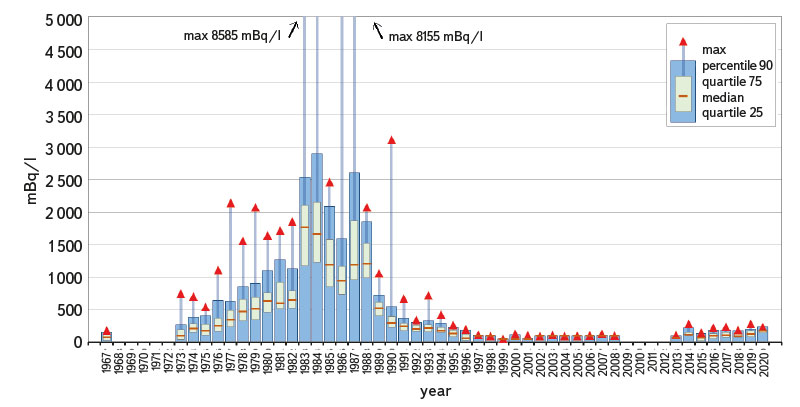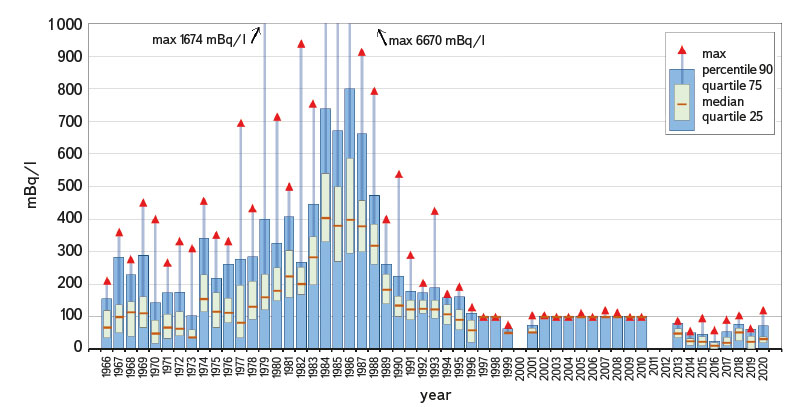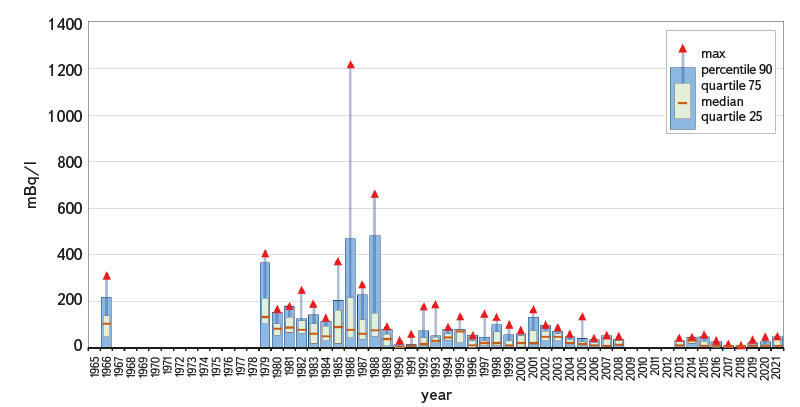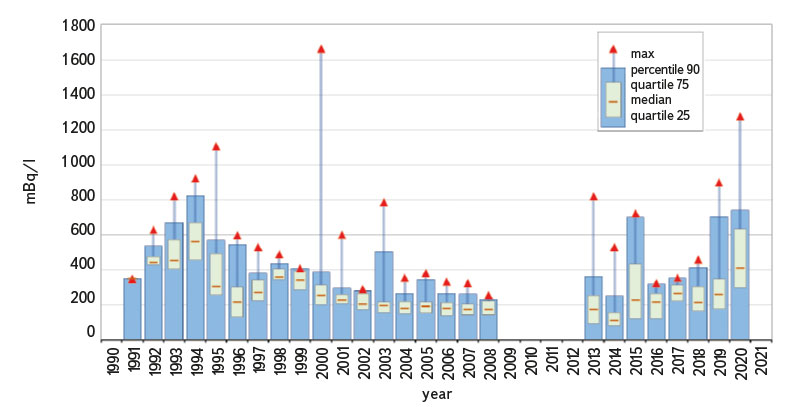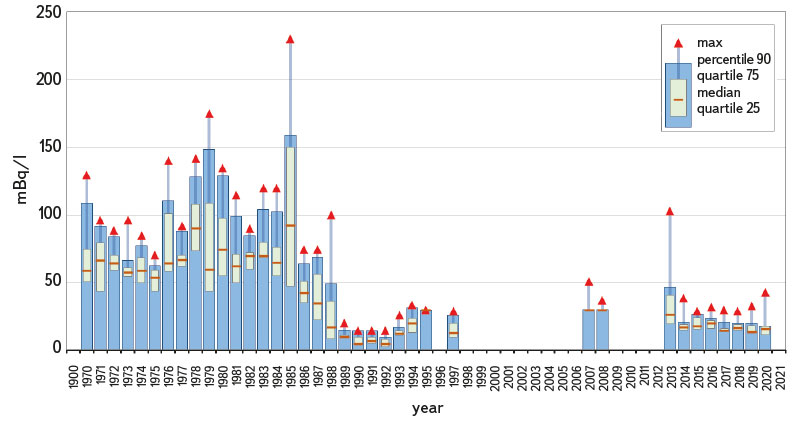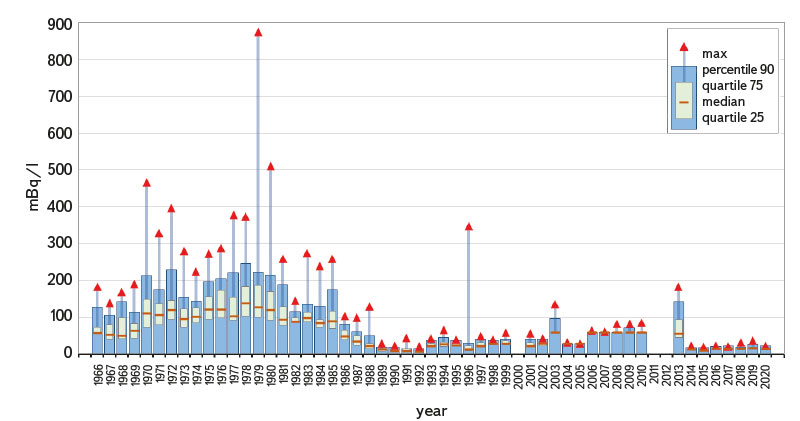ABSTRACT
The Czech Hydrometeorological Institute (CHMI) is engaged in systematic monitoring and evaluation of radiological indicators in surface waters. The article describes changes in the values of radiological indicators in surface waters in the time series from 1967 to the present. The evolution of total volume alpha and beta activity, uranium concentration, and radium activity (226Ra) is described on characteristic profiles in the area of uranium-containing raw materials mining, in the vicinity of Stráž pod Ralskem, where the mining of radioactive raw materials has already been suppressed. The Ploučnice river flows through this mining area and flows into the Elbe river in Děčín near the Hřensko border crossing, where activities of radiological indicators are also monitored and documented. Following the cessation of uranium mining at the Stráž pod Ralskem deposit, uranium concentrations dropped by two orders of magnitude, and surface waters on the Ploučnice – Mimoň profile have been classified as Class I – unpolluted water for the last five years. The values of Kendall’s correlation coefficient τ for the profiles evaluated on the selected profiles during the mining period are characterized by an increasing trend (+0.7) for the indicator of total volume beta activity; after the end of mining, a decreasing trend is indicated (-0.5).
INTRODUCTION
This article presents the results of long-term monitoring of radiological indicators in surface waters in the Ploučnice river basin. Uranium mining took place in the past in this basin in the area around Stráž pod Ralskem. The determined values of radiological indicators are predetermined by the geological structure of the area, with the occurrence of uranium mineralization and the method of extraction of raw materials containing uranium.
The aim of the article is to present the development of the activity of radiological indicators in surface waters for the entire monitored period 1967–1989 and after 1990, using archival data stored in the collection database of the Water Quality Monitoring in the Czech Republic information system (Is ARROW), which is provided and evaluated by CHMI [1].
Deposit characteristics
Uranium mineralization in the sediments of the Czech Cretaceous Basin was investigated in the first half of the 1960s. Deposit accumulations of uranium are associated with sediments of the lower (freshwater) and upper (marine) Cenomanian. The Hamr and Břevniště deposits were deep mined while the Stráž deposit was mined by the underground leaching method by wells from the surface. The Stráž mining area was gradually expanded to 24.1 km2 [12]. Descriptive data on the uranium deposit are given in a number of reports of the mining organization (DIAMO, State Enterprise) and other publications [8, 10, 11, 13, 16, 27]. A government resolution from 1990 changed the concept of energy raw material mining and, on the basis of subsequent government decisions and resolutions [23–26], uranium mining slowed down. Chemical extraction at the Stráž deposit was stopped as of 1st April 1996; in the following period, uranium was extracted from remediation of chemical extraction.
 Fig. 1. Map of the area of interest with marked profiles in Ploučnice basin (those assessed in detail are highlighted)
Fig. 1. Map of the area of interest with marked profiles in Ploučnice basin (those assessed in detail are highlighted)
METHODOLOGY
Radiological indicators in surface water samples in the Ploučnice basin have been analysed in a laboratory since 1967, coinciding with the start of uranium mining in the vicinity of Stráž pod Ralskem, which is located in the same basin.
In Ploučnice sub-basin, surface water sampling is documented on the profiles of Ploučnice, Ještědský stream, Ploužnický stream, Mlýnský náhon, Robečský stream, Dobranovský stream, and Svitávka. Mine water samples were taken during active uranium mining at the Stráž pod Ralskem deposit.
Uranium contents are determined as metal concentrations in dissolved substances (DS), in non-dissolved substances (NS), and in all substances according to ČSN 75 7614 standard [6].
Monitoring of radioactive load is carried out on the basis of determination of radioactive indicators, i.e., total volume beta activity in dissolved (DS) and non-dissolved substances (NS). In DS, the correction of total volume betaactivity to the 40K isotope content is made. Monitoring of radiological indicators is also extended and supplemented by determination of the total volume alpha activity (DS, NS) and the activity of 226Ra isotope (DS, NS) [4, 5, 7].
Classification of profiles into quality classes is carried out according to ČSN 75 7221 standard [2] from October 1998; this standard was updated in 2017 [3]. The characteristic value for inclusion in quality classes, or quality according to the updated standard, is a value with a probability of not exceeding 90 %. The frequency of sampling for the entire period of more than 55 years varied in the interval from once a week to once a month, exceptionally once every two months. For statistical processing, a characteristic value defined in the mentioned standard was used, which represents a representative value for individual years. For the calculation, the values of those indicators that were analysed on representative profiles throughout the evaluated period in a continuous series were used.
Due to the nature of the statistical distribution of the values of radioactive indicators, when describing annual activity value, the mean value of activity measurement results is calculated, and when displayed in graphs, the value of the lower (25%) and upper (75%) quartiles is also shown.
Using the non-parametric Mann-Kendall test [12, 14], the values of the correlation coefficient τ and the probability measure were calculated to determine the trend of detected values of radiological indicators on the selected profiles.
RESULTS AND DISCUSSION
An overview of monitored profiles in Ploučnice river basin (Fig. 1) and the time range of their monitoring is shown in Tab. 1. For a number of profiles, samples were not analysed in some periods (1 to maximum 5 years).
Tab. 1. Time range of monitored profiles
The highest uranium content of up to 15 mg/l were found in mine water in the 1980s, when the highest total volume beta activity was up to 684.5 Bq/l (Fig. 2). The highest volume beta activity on the monitored profiles was documented in the 1980s at Ploučnice on the Mimoň profile (81.64 Bq/l), in Stráž pod Ralskem (19.1 Bq/l), and at Mlýnský náhon on the Hamr profile (47.25 Bq /l). A clear reduction in total volume beta activity, or of this indicator, corrected for the activity of the 40K isotope, has been recorded since the 1990s. For example, on the already mentioned Mimoň on the Ploučnice profile, in the 1980s, the mean values of the total volume beta activity were in the range of 1.04–1.88 Bq/l, or in the range of 0.9–1.7 Bq/l after correction to 40K. After mining stopped in the 1990s, the mean value for the mentioned indicators decreased to 0.22–0.4 Bq/l and to 0.05–0.29 Bq/l in the case of correction to 40K. At the beginning of the 21st century, the values of total volume beta activity decreased; according to the classification of ČSN 75 7221 standard, the quality of surface water already meets the inclusion in class I (unpolluted waters) to class II (mildly polluted waters) in a number of consecutive years. In recent years, the characteristic value of beta activity for inclusion in the quality class, as well as the mean value of the monitored indicator, have not decreased significantly.
 Fig. 2. Total volumetric beta activity in mine water (Hamr 3 deposit)
Fig. 2. Total volumetric beta activity in mine water (Hamr 3 deposit)
According to ČSN 75 7221 standard, the characteristic value of uranium classifies the quality of surface water on the Mimoň profile on the Ploučnice river during the 1980s into class V – very heavily polluted water. In the course of the 1990s, after the change in the use of uranium deposits, an improvement of one qualitative class to class IV – heavily polluted water – was recorded on this profile as well. Uranium concentrations decreased by one order of magnitude and did not exceed 10 µg/l on this profile in the last 20 years (Fig. 3). Only in Stráž pod Ralskem on Mlýnský náhon, uranium concentration of 54.5 µg/l was detected even after 2000.
 Fig. 3. Uranium content, Ploučnice – Mimoň profile
Fig. 3. Uranium content, Ploučnice – Mimoň profile
Reduction in radiological indicator activity is demonstrable on profiles located lower in the direction of the Ploučnice river flow. On the higher Mimoň profile on the Ploučnice River, in the 1980s, the mean value of the total volume beta activity after correction to 40K is in the range of 0.6–1.66 Bq/l; based on the characteristic value it belongs to class V – very heavily polluted water (Fig. 4). On the lower profile in Březiny, the surface water is classified as class IV – heavily polluted water, the mean value is 0.182–0.405 Bq/l (Fig. 5). On the Hřensko border profile below the outlet of the Ploučnice to the Labe/Elbe, the mean value is 0.053–0.092 Bq/l, and in the 1980s, the water was classified on the basis of the characteristic value into class III – polluted water; in the last 10 years the characteristic value is suitable for classification into class I – unpolluted water (Fig. 6).
 Fig. 4. Total volume activity of beta cor. 40K, Ploučnice – Mimoň profile
Fig. 4. Total volume activity of beta cor. 40K, Ploučnice – Mimoň profile
 Fig. 5. Total volume activity of beta cor. 40K, Ploučnice – Březiny profile
Fig. 5. Total volume activity of beta cor. 40K, Ploučnice – Březiny profile
 Fig. 6. Total volume activity of beta cor. 40K, Labe – Hřensko profile
Fig. 6. Total volume activity of beta cor. 40K, Labe – Hřensko profile
The value of total volume alpha activity was not determined before 1990. Alpha activity has been decreasing since the mid-1990s; in the last 10 years, for example, increasing values of volume alpha activity have been recorded on the Ploučnice – Mimoň profile (Fig. 7).
 Fig. 7. Total alpha volume activity, Ploučnice – Mimoň profile
Fig. 7. Total alpha volume activity, Ploučnice – Mimoň profile
Activity of 226Ra isotope on the monitored profiles during the period of intensive mining reached high values; on the Ploučnice – Mimoň profile up to 9,104 mBq/l, according to the classification, the surface water quality corresponded to class V – very heavily polluted water. After the end of intensive mining, activities decreased significantly in the 1990s. After a short period of interruption of monitoring and after its resumption about 10 years ago, the activity of the 226Ra isotope increased, and in the last few years, based on the detection of the activity of this isotope, the water quality is classified as class II – slightly polluted water (Fig. 8, 9).
 Fig. 8. Activity of 226Ra, Ploučnice – Osečná profile
Fig. 8. Activity of 226Ra, Ploučnice – Osečná profile
 Fig. 9. Activity of 226Ra, Ploučnice – Březiny profile
Fig. 9. Activity of 226Ra, Ploučnice – Březiny profile
Tab. 2. Mann-Kendall test results
I = increasing, D = decreasing
For the selected profiles, a trend analysis was performed for the monitored indicators. The results of the Mann-Kendall test and the values of the Kendall correlation coefficient τ for the evaluated profiles and selected indicators are shown in Tab. 2.
Based on previous evaluation of analytical data, the year 1990 was chosen as the turning point; due to societal changes, there was also a change in the use of energy resources. For the total beta volume activity and total beta volume activity corrected to 40K, an increasing trend was confirmed before 1990 on each of the three evaluated profiles. After 1990, a downward trend was confirmed for the above-mentioned indicators; however, the trend can be confirmed by statistical calculation with high probability only for two profiles. For the 226Ra isotope, neither a decreasing nor an increasing trend was confirmed in any of the defined periods.
CONCLUSION AND EVALUATION
Based on monitoring of radioactive indicators for the period 1967–2021, the following can be evaluated from the results of laboratory determinations of surface water samples on profiles in the Ploučnice river basin:
- significant influence of the occurrence of uranium ore mined in the Stráž pod Ralskem deposit on surface water quality;
- at the time of active mining in the period 1967–1996, increased values of radioactive indicators were detected in surface waters, decreasing in the direction of the flow;
- the distant Hřensko profile on the Labe/Elbe River showed the influence of radioactive indicators during the active mining of uranium ores;
- based on a statistical calculation, a downward trend was confirmed for the total volume beta activity and total volume beta activity after correction to 40K after the end of uranium ore mining;
- in the last 10 years, increasing values of volume alpha activity have been recorded on the Mimoň profile on the Ploučnice;
- the normative trend was not confirmed for the activity of 226Ra isotope.
The Czech version of this article was peer-reviewed, the English version was translated from the Czech original by Environmental Translation Ltd.
